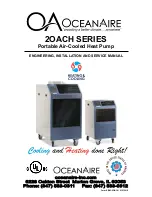
10
F)
ELIMINATION OF AIR WITH THE PUMP
OF THE VACUUM (Fig 8)
Air and moisture in the refrigeration system can
cause side effects as shown below:
To avoid the above, the internal assembly and the
tubes,
places between internal and external group,
must be
tested for leaks and purged to remove
non-
condensing elements and humidity from the system.
Check that each tube, (is the gas side tubes
that of the
liquid) between internal group and external group,
has
been connected in the correct way and that all
wiring
necessary for testing have been carried out.
Remove
the valve cap on the assembly
external. Make sure that
both are now
gas and liquid valves remain
closed
.Check the length of the tube and its quantity of
the refrigerant for a correct charge, check the
overheating value.
Fig. 8
ATTENZIONE!
WARNING!
To make sure to perform the
procedure of emptying with
the group in COLD MODE
.
- Increased pressure in the system.
- Increased current consumption.
- Decreased refrigerant efficiency.
- Freezing and obstruction of the pipes
capillaries.
- Corrosion of the parts of the system of
refrigeration.
When you change places in the unit, carry it out
bleeding with the vacuum pump. Make sure the
refrigerant inside the conditioner is always
in liquid state.
External units are supplied with a charge of
R410A refrigerant gas suitable for guaranteeing
correct operation
operation up to a maximum distance of 5
meters from the indoor unit.
If you decide to install the 2 units at one
distance greater than 5 meters, be sure to add
20 g of refrigerant gas per meter more than
piping (Tab. 3).
For example, if there are external and internal units
7 meters of piping add 40 g of R410A gas.
In any case, never exceed 15 meters.
Do the addition only after making the
vacuum in the pipes that connect the 2 units, such
as illustrated in chapter 3.4, after which you can
proceed with the opening of the gas taps, mounted
on board machine.
G) EVACUATION
Connect the end of the charging hose to the
vacuum pump to evacuate the air from the pipes
of the internal unit. Check that the knob
"LO" of the pressure gauge valve is open.
Then run the vacuum pump. The time of
operation varies depending on the length of the
tubes and pump capacity.
When the desired vacuum is reached, close
the "LO" knob on the pressure gauge valve e
stop the vacuum pump. In conclusion, using
a wrench for service valves, rotate the stem
of the gas side valve counter clockwise for
open it completely.
Loosen the charging hose connected to the socket
gas side service to relieve pressure, then
remove the tube. Replace the cover nut on the
gas valve and service outlet and tighten
well with an adjustable wrench.
This procedure is very important to avoid
plant leaks Replace the service valve caps either
on the gas side than on the liquid side and tighten
well.
This completes the air purge procedure
with the vacuum pump, make sure all the pipes
are connected correctly and that the valves of
service of the gas and liquid sides are completely
open.











































